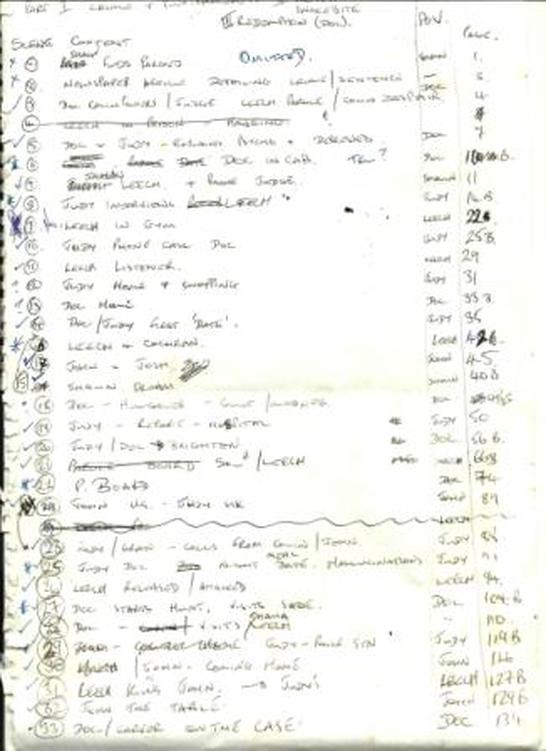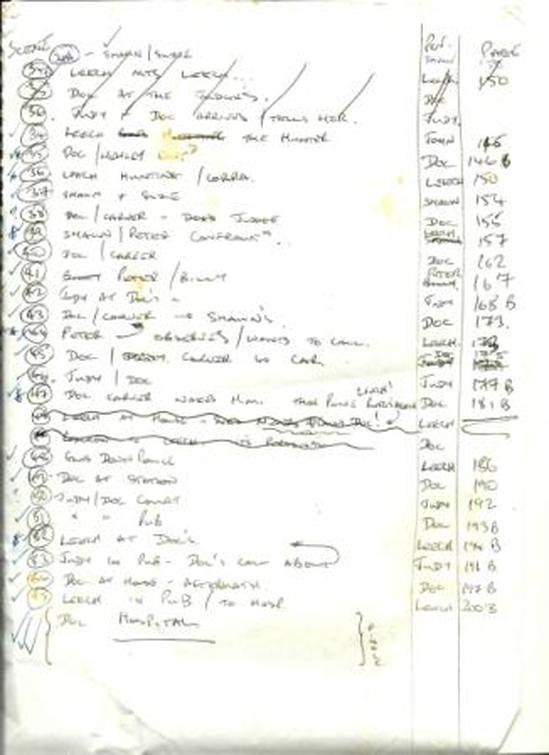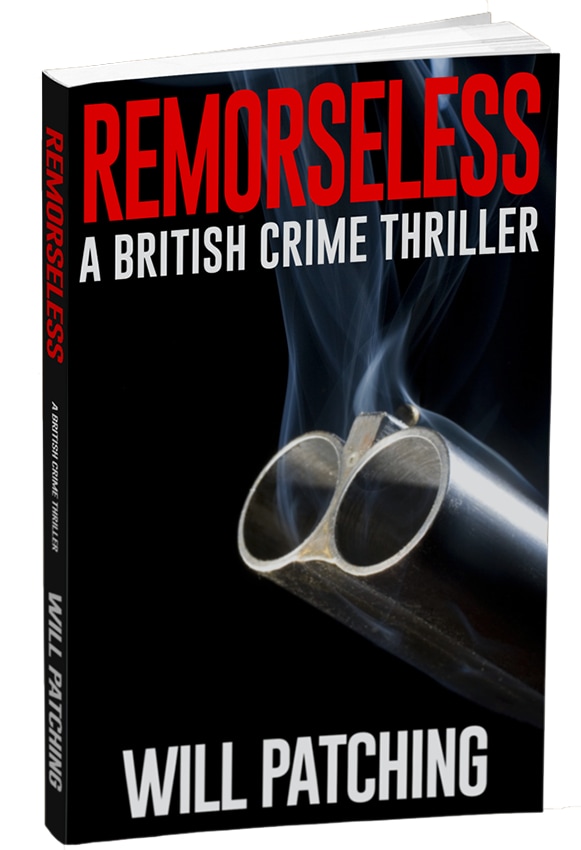Structure - a different approach to the writing process
The scenes

Most writers tend to start with something like this - but rather better organized and clearer too: a complete plan listing all the chapters in the novel so that they know exactly where they are going.
They also usually have character bios in far more detail than mine, maybe even a synopsis of each chapter ready to flesh out fully, and maybe have even written the last chapter in full. This is great if you like to know exactly where you are going and precisely how you plan to get there.
I don't.
My approach is more spontaneous; this document was created on the hoof. As I followed King's advice and started 'getting the story down' I mentally noted what the upcoming few scenes should contain and made a note on these sheets as I went along.
I'd usually have an idea of what I needed to write for these scenes/chapters bubbling in my mind as I was writing the current one. To keep on top of this I would make hasty side notes as a reminder too, as well as pop the scene description in here, before getting back to my main focus.
They also usually have character bios in far more detail than mine, maybe even a synopsis of each chapter ready to flesh out fully, and maybe have even written the last chapter in full. This is great if you like to know exactly where you are going and precisely how you plan to get there.
I don't.
My approach is more spontaneous; this document was created on the hoof. As I followed King's advice and started 'getting the story down' I mentally noted what the upcoming few scenes should contain and made a note on these sheets as I went along.
I'd usually have an idea of what I needed to write for these scenes/chapters bubbling in my mind as I was writing the current one. To keep on top of this I would make hasty side notes as a reminder too, as well as pop the scene description in here, before getting back to my main focus.

I kept a careful note of whose Point of View (POV) I was writing under so that I could add tension to certain scenes by excluding some characters from really knowing what was happening or what was in the POV character's mind.
In my novel The Hack, I have far more POV characters as it is an international action thriller, jumping continents as the plot unfolds, with little of the psychological stuff that is threaded through Remorseless.
POV is a useful tool for helping the reader identify with the characters too. By allowing them to dip into the thoughts and motives behind the action you can create tension and suspense - for example, when the characters are lying or doing something dreadful, unbeknownst to the rest of the 'cast'.
You'll notice quite a few deletions and reordering of sections too - the process is not as exact as the usual recommended 'properly structured' approach, and I know my way of doing things is not for everyone.
In my novel The Hack, I have far more POV characters as it is an international action thriller, jumping continents as the plot unfolds, with little of the psychological stuff that is threaded through Remorseless.
POV is a useful tool for helping the reader identify with the characters too. By allowing them to dip into the thoughts and motives behind the action you can create tension and suspense - for example, when the characters are lying or doing something dreadful, unbeknownst to the rest of the 'cast'.
You'll notice quite a few deletions and reordering of sections too - the process is not as exact as the usual recommended 'properly structured' approach, and I know my way of doing things is not for everyone.
|
The Remorseless ebook is normally $3.99. Grab your FREE copy today - this is a time limited offer...
|
Author's comments on Remorseless
I generally write scenes rather than chapters - there is a difference, if only in my mind.
My scenes tend to be shorter than the usual chapter length in novels, and this reflects my visual style. The story unveils itself in a sort of movie format in my mind and that results in these scenes of varying length, from a single page to maybe twenty or more. Some writers try to keep their chapters consistent in length - I have no idea how to do that as the structure of mine totally depends on the actions of the characters. The original novel is split into three main sections with a prologue and epilogue, broken into scenes. The three main parts represent the traditional acts in a play, sort of(!), and the titles each represent protagonist's travails rather than, as people may think at first glance, our evil villain Leech's progress. Let me know what you think! Will Patching |
|
Subscribe to Will's occasional newsletters for giveaways, prize draws and Free Stuff!
|
